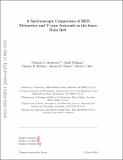A spectroscopic comparison of HED meteorites and V-type asteroids in the inner Main Belt
Author(s)
Moskovitz, Nicholas; Willman, Mark; Burbine, Thomas; Binzel, Richard P.; Bus, Schelte J.
DownloadBinzel_A spectroscopic.pdf (1.494Mb)
OPEN_ACCESS_POLICY
Open Access Policy
Creative Commons Attribution-Noncommercial-Share Alike
Terms of use
Metadata
Show full item recordAbstract
V-type asteroids in the inner Main Belt (a < 2.5 AU) and the HED meteorites are thought to be genetically related to one another as collisional fragments from the surface of the large basaltic Asteroid 4 Vesta. We investigate this relationship by comparing the near-infrared (0.7–2.5 μm) spectra of 39 V-type asteroids to laboratory spectra of HED meteorites. The central wavelengths and areas spanned by the 1 and 2 μm pyroxene–olivine absorption bands that are characteristic of planetary basalts are measured for both the asteroidal and meteoritic data. The band centers are shown to be well correlated, however the ratio of areas spanned by the 1 and 2 μm absorption bands are much larger for the asteroids than for the meteorites. We argue that this offset in band area ratio is consistent with our currently limited understanding of the effects of space weathering, however we cannot rule out the possibility that this offset is due to compositional differences. Several other possible causes of this offset are discussed.
Amongst these inner Main Belt asteroids we do not find evidence for non-Vestoid mineralogies. Instead, these asteroids seem to represent a continuum of compositions, consistent with an origin from a single differentiated parent body. In addition, our analysis shows that V-type asteroids with low inclinations (i < 6°) tend to have band centers slightly shifted towards long wavelengths. This may imply that more than one collision on Vesta’s surface was responsible for producing the observed population of inner belt V-type asteroids. Finally, we offer several predictions that can be tested when the Dawn spacecraft enters into orbit around Vesta in the summer of 2011.
Date issued
2010-03Department
Massachusetts Institute of Technology. Department of Earth, Atmospheric, and Planetary SciencesJournal
Icarus
Publisher
Elsevier
Citation
Moskovitz, Nicholas A. et al. “A Spectroscopic Comparison of HED Meteorites and V-type Asteroids in the Inner Main Belt.” Icarus 208.2 (2010): 773–788.
Version: Author's final manuscript
ISSN
0019-1035
1090-2643